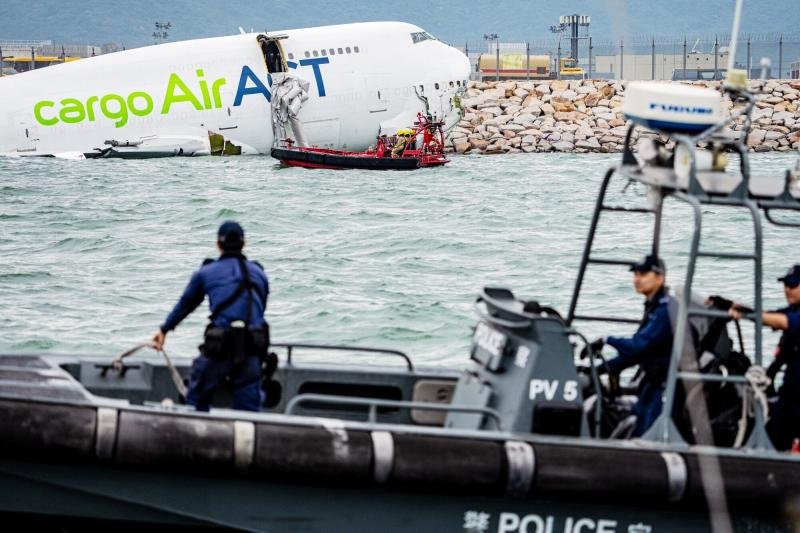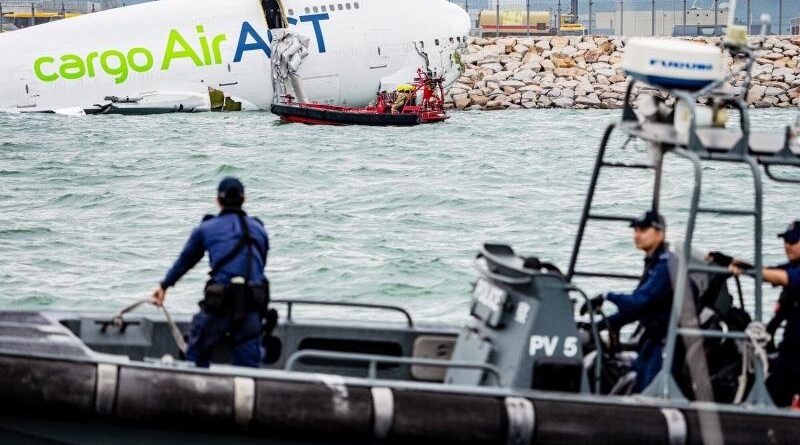Hong Kong launches probe after plane skids off runway, kills 2, in ‘suitable’ weather

Weather and runway conditions at Hong Kong’s airport were suitable for normal operations when a cargo plane veered off the runway early Monday and ploughed into the sea, killing two people, authorities said as they launched an investigation into the incident.
The Civil Aviation Department also said air traffic controllers had not received any calls for assistance from Emirates flight EK9788, which was operated by Turkish cargo and passenger charter carrier ACT airlines before the crash.
Meanwhile, police said they have not ruled out launching a criminal investigation into the matter.
At about 3.50am (2.50am Thai time), the Boeing 747 freighter swerved off the runway during landing and into the waters off the airport’s north runway while knocking a security patrol vehicle into the sea.
Two men aboard the vehicle were initially reported missing. One, aged 30, was pulled by rescue divers from the sea and confirmed dead at the scene at 5.55am. The other, aged 41, was sent to North Lantau Hospital and was confirmed dead at 6.26am.
The pair had been working at the airport for seven and 12 years, respectively.
A source said the younger man who died, Chan Chun-yin, was a passenger in the vehicle, while the older man, Vincent Ho Kwok-cheung, was the driver.
All four of the flight’s crew, who were Turks, were rescued and sent to North Lantau Hospital for treatment.
They were captain Atilia-silifke Yilmaz, 35, first officer Candemir Ulker, 44, aircraft maintenance engineer Muzaffer Tuydu, 46, and loadmaster Caner Durgut, 35, the source added.
A spokesman for the Transport and Logistics Bureau expressed deep concern over the accident and sadness over the deaths of the ground staff, extending condolences to their families.
The spokesman added that flight safety was of “paramount importance” and that the Air Accident Investigation Authority would “actively investigate” the cause of the incident.
“The Civil Aviation Department and the Airport Authority Hong Kong will fully cooperate to ensure safe airport operations,” the spokesman said.
The cargo aircraft was wet-leased and operated by ACT Airlines, an Emirates spokesperson said.
A wet lease is an arrangement in which an airline provides an aircraft and crew to another airline, according to the US Federal Aviation Administration.
ACT Airlines performs unscheduled air cargo to provide extra capacity for major carriers, according to its website.
The Emirates spokesperson added that the crew were safe and there was no cargo on board at the time of the incident.
Emirates also said that as all operational matters related to the aircraft were handled by ACT Airlines, it was unable to provide any further comment.
ACT Airlines confirmed that the four crew were in “good health” and expressed its sorrow over the tragedy. “We extend our deepest condolences to the families and loved ones of those who lost their lives,” it said.
It added that while the cause of the crash had yet to be determined, it would cooperate with local authorities “with utmost diligence” throughout the investigation.
Steven Yiu Siu-chung, the Airport Authority’s executive director for airport operations, said the weather and runway met all conditions for normal operations.
He also stressed that the security vehicle that was hit was “absolutely not near the runway” and had been outside the fence patrolling along the 4-kilometre-long northern coastline to ensure airport safety, adding it was common practice since 1998.
Yiu added that an investigation into the crash would have to be completed before the aircraft could be removed from the north runway, while the south and centre runways would remain operational.
“We don’t expect any impact on today’s operations,” he said, referring to over 1,000 flights scheduled on Monday.
According to the Civil Aviation Department, air traffic controllers were directing the aircraft to land on the north runway, but did not receive any call for assistance from the plane.
When the plane deviated from its route and took a left turn in the middle of the runway, air traffic controllers immediately notified the Airport Authority and other relevant rescue units, the department said.
It added that about six flights – five arriving and one departing – had been affected by the incident and experienced delays of about 5 to 15 minutes.
Asked by reporters whether the pilot would be held criminally liable, Yip Pun-yu, commander of police’s airport district, said that the force would work closely with the Air Accident Investigation Authority on the probe.
“We do not rule out launching a criminal investigation,” he said.
Yiu Men-yeung, assistant director of the Fire Services Department in New Territories South, said staff were alerted shortly before 4am about the crash. Upon arrival, fire services staff observed the aircraft split into two pieces floating on the sea.
The plane’s four crew members were spotted at the aircraft’s exit waiting to be rescued, he said. They eventually evacuated via the evacuation slide.
Staff also knew that the security patrol car had been affected and immediately rushed to rescue them, Yiu added.
Divers found the vehicle about 40 minutes later with the two security staff inside, five metres from the shore and at a depth of seven metres, he said.
In total, 213 fire services and ambulance personnel were deployed.
While Hong Kong International Airport is one of the safest in the world, Monday’s incident marked the second time in less than two months that a plane veered from the usual course along its north runway.
On Sept 8, authorities launched a probe into a “serious incident” involving an HK Express flight suspected of deviating after landing and hitting some signboards amid a typhoon.
The north runway was commissioned in 2022 as part of the highly anticipated HK$141.5 billion (600 billion baht) three-runway system meant to advance the city’s status as a global transport and aviation hub.
According to the Airport Authority, the north runway is dedicated to arrivals, while the centre runway is for departures, and the south runway operates in mixed mode for both arrivals and departures.
Warren Chim Wing-nin, deputy chairman of the Hong Kong Institution of Engineers’ aircraft division, said the possibility that the relatively new north runway was a factor in the crash was “a bit remote.”
He added that the two so-called black boxes on board the aircraft – the flight data recorder and cockpit voice recorder – would contain the “fundamental” information needed to ascertain the cause of the incident.
He said there was speculation the plane had been blown off course, though he emphasised that aircraft were designed to withstand very strong winds during landing and that such information would be contained in the data recorder.
Authorities would have to take the data from the two recorders and cross-examine the information by talking with the crew on board, he said.
“All this will give us a full picture about what happened,” he said.
Steven Dominique Cheung, chairman of the Hong Kong Professional Airline Pilots Association, said even if the weather and runway conditions were considered suitable for normal operations, various factors could cause a runway incident.
“‘Suitable for regular operations’ does not mean ‘no risk’ for a specific aircraft on a specific approach and rollout – small variances in speed, touchdown point, wind and braking configuration can materially change the stopping margin,” he said.
“At this stage, it would be premature to assign weight to any one factor; the Air Accident Investigation Authority’s work will be decisive,” he said.
He added that the north runway was certified to international standards and handled heavy aircraft routinely.
Monday’s tragedy was just the second deadly accident at the airport since it moved from Kai Tak to Chek Lap Kok in July 1998.
In August 1999, a China Airlines passenger flight crashed while landing during a typhoon, killing three people, but 312 survived the accident.
Source – Bangkok News




